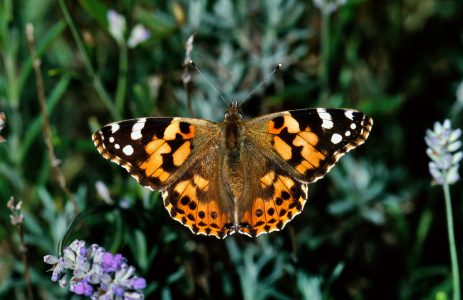
Photo credit: Mike Brown
When you think of far-ranging animals found across all the continents, your mind probably goes straight to birds. But would you believe there’s a species of butterfly that does just as much exploring?
The painted lady (Vanessa cardui) is the most widespread species of butterfly in the world. It occurs natively across Europe, Asia, Africa, and North America, and is a visitor to Ireland in the summer. Because it’s found in so many places and travels around so much, it’s also known as the cosmopolitan butterfly.
With its bold orange and black wing patterns, the painted lady certainly is eye-catching. Like all butterflies, it’s a pollinator and is most commonly on the wing in summer and early autumn when there are plenty of flowers for it to feed on and plants for it to lay its eggs on. Most butterflies breed at specific times of year, but the painted lady has no fixed breeding season. Adults mate and lay eggs whenever and wherever conditions are favourable.
The painted lady’s larval form is an unassuming black and slightly hairy caterpillar, a far cry from the adult butterfly it metamorphoses into. Adults are fairly choosy about which plants they lay their eggs on, although the painted lady is much less picky than some other butterfly species. They like thistle plants the most, and once the eggs hatch, the caterpillars will spend about two weeks eating everything they can before they become a pupa.
Perhaps the painted lady’s most well-known trait is its fantastic migrations. Unlike most migratory animals, the painted lady doesn’t migrate every year, nor does it migrate to the same place every year. Instead, groups of butterflies will take off and migrate somewhere whenever climate conditions make it favourable to do so. Some people in mainland Europe have been lucky enough to witness the sight of clouds of butterflies millions strong flying off to some distant place.
Painted ladies never overwinter in Ireland, as it’s too cold for them to survive here. If we get them at all, it’ll be in summer. They also don’t always come here. Some years, they’re everywhere. Other years, they’re incredibly rare. Most of our painted ladies appear to be migrants from north Africa, which is quite a long way for a tiny little butterfly to travel!
Painted ladies are better fliers than you’d expect, though. They fly very high, especially compared to other butterflies, and they move surprisingly fast. Research suggests that they navigate visually, using the sun as a compass. For a long time, no one was sure whether butterflies who migrated to Ireland were capable of making a return trip, but newer studies suggest that some of them do in fact migrate away again at the end of the summer.
Because painted ladies move around so much, it’s hard for the males to hold fixed territories to attract females. Instead, the male will find a perch wherever he happens to be and wait for females to visit him, chasing off any rival males who come near him. Males will mate with many females, and the females produce a lot of offspring. For some reason, they like to migrate to rainy places, possibly because the moisture has some kind of effect on their reproduction.
Painted lady migrations aren’t tied to any particular year or season. Some years, they don’t migrate at all, and we won’t see any in Ireland. Other years, they migrate here in summer, breed, and then leave again or die in autumn. Research suggests that their migrations in some places might be linked with El Nino, which is an occasional climatic phenomenon where the seas around South America are warmer than usual and cause a knock on effect to the rest of the world.
Like all butterflies, the painted lady has an important place in many cultures. Butterflies are often associated with change and rebirth, with their growth from caterpillar to pupa to butterfly frequently being taken as a metaphor for life, death, and the afterlife. In Ireland, butterflies are said to be the souls of the departed traveling on their way to heaven, and if a butterfly comes into your house or lands on you it’s said to be a loved one paying you a visit. Painted ladies, with their tendency to wander, are especially associated with the travels of the deceased.
As well as being representations of the soul, painted ladies are commonly used as ambassador animals. They’re easygoing and hardy, as butterflies go, which makes them an ideal species for schoolchildren to learn about. In some places, teachers keep painted lady caterpillars in class terrariums so the children can watch them grow and eventually release the adult butterflies in suitable locations.
It’s critically important to teach children and adults alike about the importance of pollinators like the painted lady. The vast majority of flora we depend on for important things like food and oxygen rely on insects to pollinate them. Some plants can only be pollinated by specific butterflies or bees. When the insects vanish, so do the plants, and it all just snowballs from there.
The painted lady might be a hardy, resilient species which can handle changes in vegetation, but many other butterflies require specific plants to breed on, and many of those plants are considered ‘weeds’. Not even the painted lady can cope with constantly mowed lawns and sprayed herbicides. So remember to make your garden as hospitable a place as possible for all these wonderful invertebrates, so the painted ladies can keep finding a safe place to rest here in years to come.
You can find all sorts of useful tips to make your garden a haven for wild pollinators over on the All-Ireland Pollinator Plan’s website, and the UK-based Butterfly Conservation has even more advice that still applies to Irish gardens.
By Grace Bettayeb, 19/05/22